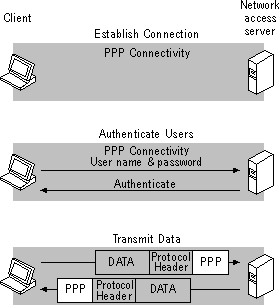
PPP is a remote access protocol used by PPTP to send multi-protocol data across TCP/IP-based networks. PPP encapsulates IP, IPX, and NetBEUI packets between PPP frames and sends the encapsulated packets by creating a point-to-point link between the sending and receiving computers.
Most PPTP sessions are started by a client dialing up an ISP network access server. The PPP protocol is used to create the dial-up connection between the client and network access server and performs the following three functions:
·Establishes, maintains, and ends the physical connection. The PPP protocol uses a sequence defined in RFC 1661 to establish, maintain, and end connections between remote computers.
·Authenticates users. PPTP clients are authenticated by using the PPP protocol. Clear text, encrypted, or Microsoft encrypted authentication can be used by the PPP protocol.
·Creates PPP datagrams that contain encrypted IPX, NetBEUI, or IP packets. PPP creates datagrams which contain one or more encrypted IP, IPX, or NetBEUI data packets. Because the network packets are encrypted, all traffic between a PPP client and a network access server is secure.
This entire process is illustrated in the following figure.
